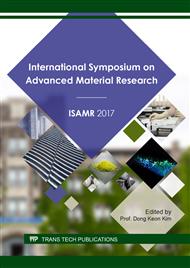p.277
p.285
p.290
p.295
p.300
p.305
p.310
p.315
p.321
Experimental Study on the Performance of Compound Improved HLLS (High Liquid Limit Soil) with Various Curing Agents
Abstract:
The HLLS (high liquid limit soil) has the characteristics of high moisture content, low bearing capacity and poor water stability. Most of the existing treatment methods focus on the improvement with a single curing agent, and the research on the improvement of HLLS with various curing agents is still insufficient. This paper presents the characteristics of two kinds of compound improved HLLS based on unconfined compressive strength test. The results show that the unconfined compressive strength of CSIS (Cement / SAP Improved Soil) and CLIS (Cement / Renolith Improved Soil) are greatly improved than those of CIS (Cement Improved Soil) when the curing age is 28d, respectively. The maximum increments of unconfined compressive strength are 0.31MPa and 0.22MPa, respectively. When the cement content is less (more) than 3%, the unconfined compressive strength of CSIS decreases (increases) with the increase of SAP content. When the cement content is constant, the unconfined compressive strength of CLIS increases first and then decreases with the increase of the Renolith content. The optimum mix amount of SAP (Renolith) and cement in CSIS (CLIS) are 0.06% (0.2%) and 5% (3%), respectively. The strength and crack resistance of the two kinds of compound improved soil are better than the one with single curing agent. SAP and Renolith exert the properties of self-curing after water absorption and hydrophobicity, respectively.
Info:
Periodical:
Pages:
300-304
Citation:
Online since:
August 2017
Authors:
Keywords:
Price:
Сopyright:
© 2017 Trans Tech Publications Ltd. All Rights Reserved
Share:
Citation:


